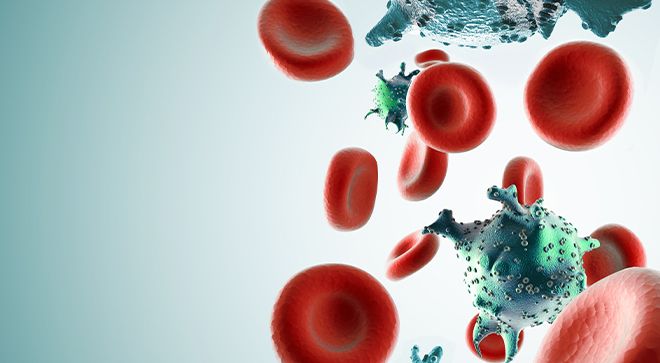Video
The Basics of Mantle Cell Lymphoma
Transcript:
Kristie L. Kahl: To start, can you discuss the major differences between a non-Hodgkin and Hodgkin lymphoma?
Lee Greenberger: There are about 70,000 new cases of lymphomas, and they basically fall into Hodgkin and non-Hodgkin. Hodgkin lymphoma has a very characteristic cell, which we can see on the microscope called a Reed Sternberg cell, and that so-called classical Hodgkin lymphoma is an absolute signature. And most pathologists will see those cells under a microscope and (know) that Hodgkin lymphoma will require a completely different treatment than non-Hodgkin lymphoma.
Now, when you talk about non-Hodgkin lymphoma, you’re really talking about a pretty large family of different types of non-Hodgkin lymphoma. In order of commonality, diffuse large B cell lymphoma, follicular lymphoma, marginal zone lymphoma, mantle cell lymphoma, and then it goes down from there. Diffuse large B cell lymphoma can be 25,000 patients a year, Waldenstrom’s macroglobulinemia, which is a very rare one, is about 1,000 patients per year.
So, it is very important to figure out what type of lymphoma you have, in particular non-Hodgkin lymphoma. These will all be treated in different ways and have different prognoses.
Kristie L. Kahl: So, more specifically, what is mantle cell lymphoma and how is it diagnosed?
Lee Greenberger: So, mantle cell lymphoma is about 5,000 new patients per year in the US. It is regarded as aggressive lymphoma. So, there are aggressive and more indolent lymphomas. DLBCL and mantle cell lymphoma fall into the aggressive category, follicular lymphoma typically is a less aggressive, more indolent lymphoma.
When you are looking at mantle cell lymphoma, you need to figure out is it indeed mantle cell lymphoma? So, the patient may walk in with a swollen node, fatigue, weakness — these vague symptoms where something might be going on in the blood system. A biopsy needs to be done, of the node or the bone marrow, and look for characteristic signatures of mantle cell lymphoma.
It turns out that within these lymph nodes, there is a very characteristic pathology and a very characteristic morphology of these cells. And they sit in a certain region in the nodes, even just by telling in the nodes where the cells are, we begin to identify if it’s mantle cell lymphoma or not. The so-called mantle region is the signature for this lymphoma. Then you need to go beyond that.
There are certain areas in these cells, will that be in the chromosomes or even mutations in particular for mantle cell lymphoma, and once those are done, an expert will look at the chromosomes and see how they appear — very characteristic or signature of mantle cell lymphoma. So, a physician or pathologist will make the call.
Kristie L. Kahl: Where are we most recently with treatment options for mantle cell lymphoma?
Lee Greenberger: Mantle cell lymphoma is considered an aggressive lymphoma that, for the most part, is considered not curable. What does that mean? If you are a patient, and you hear those words “not curable,” it’s a very frightening term. What it means, is that ultimately we don’t think that we can get rid of the disease. That doesn’t mean that you can’t live with the disease. If you can get long-term disease control, that can be just as valuable as a cure — basically keeping this at bay. And we do that for mantle cell lymphoma for about five or 10 years, at least with the previous therapies, and I’ll tell you about an exciting therapy when I get to it in a moment.
So, mantle cell lymphoma will typically be treated with a cytotoxic therapy along with an antibody — that’s Rituxan (rituximab) – will be a very typical therapy for mantle cell, and typically you will get a response but it will not last and patients will come back two years, five years with a relapsed disease. And then we can either retreat or, more commonly, move to other therapies.
That is where the newer immunotherapy is coming in. There have not been a lot of options for mantle cell lymphoma patients until lately. One of these options is CAR T-cell therapy. The results of the trial were (recently presented at the American Society of Hematology annual meeting), and they are quite exciting. So, what CAR T-cell therapy is, you basically take the T cells out of these patients. The T cells are immune cells, you put a homing device, essentially, in those cells so that we can genetically engineer a new protein in those cells. That protein will guide those T cells when placed back in the patient, to the tumor cells and they will kill the tumor. Why is this so important? So, the CAR T therapy, the so-called CD19 therapy where you basically take the cells and put in CD19-directed therapy, there is an antibody on those engineered cells that is looking for CD19 on the tumor cells.
When it recognizes that, it tells the T cells to turn on and multiple and kill that tumor. So, it’s sort of like a homing device. So that CD19 CAR T-cell therapy, which is approved for DLBCL and for leukemia. When you put those into mantle cell lymphoma patients, who have relapsed or refractory disease, you can get a very high response rate. So, the tumors will shrink, you’ll get an 80%-90% response rate, but more importantly, the data is showing us that about 50% of those patients will have long-term disease control out about three years, which means we look like we have new therapy. It is yet to be FDA approved, but it is highly encouraging that we have yet another new therapy to treat mantle cell patients.
Kristie L. Kahl: In addition, to CAR T-cell therapy, is there anything else exciting coming in the pipeline?
Lee Greenberger: (Imbruvica [ibrutinib]) is an oral therapy directed toward something called BTK. BTK is a switch inside the mantle cells, so when it is turned on it will activate a growth pathway. You’ll get abnormal growth of those cells. Ibrutinib is a BTK inhibitor that shuts down that pathway. So, that’s one piece but the problem with ibrutinib is, unlike chronic lymphocytic leukemia where ibrutinib works well, it does not work that well in mantle cell lymphoma. However, ibrutinib plus another oral drug called (Venclexta [venetoclax]) when used in combination is now giving exciting results of prolonged disease control in mantle cell lymphoma patients. So, you’re taking two oral medications which are both approved for mantle cell lymphoma, and in combination, it looks like they have long-term disease control. So, there are multiple options.
There is also something called a CDK4/6 inhibitor, called (Ibrance [palbociclib]), which is used in breast cancer. It has a very interesting story. Palbociclib in breast cancer actually came out of work (to treat) the lymphomas. So, there was an investigator who tried to understand how CDK4 plays a role in blood cancers. She found an interesting result that the drug was put on the sidelines. And once she started getting interesting results in lymphoma, the company that owned the drug, there was new data that came out (showing) CDK4/6 inhibitors may be useful in breast cancer. So, the drug was approved for breast cancer and has now gone back to being used in combination with ibrutinib for mantle cell with good results.
This is typical in cancer research. These drugs find homes in places that you don’t expect. So, doing basic research to understand where these drugs work and how these pathways are operating — sort of the wiring system, if you will – is really important because it provides new ways to use drugs that are already approved.
Kristie L. Kahl: What is your biggest piece of advice for a patient who is newly diagnosed with mantle cell lymphoma?
Lee Greenberger: Understand that, unlike breast cancer which occurs in over 200,000 women per year in the US, mantle cell lymphoma occurs in 5,000 patients per year. This means that you need a specialist to recognize what it is, and you need a good pathologist who is going to look at the slides to make the call to decide if it’s mantle cell or not. The best advice is if you walk in with swollen lymph nodes and fatigue, are going to go do a blood test, that is the start of it but you really need to go to a trained hematologist/oncologist who has seen mantle cell lymphoma multiple times to figure out what the best therapy. And quite often, it means going to a major medical center that deals with mantle cell lymphoma and has seen hundreds of patients.
Beyond that, because most of the advances are happening now in clinical trials, it is best to get to a major medical center that is running clinical trials in mantle cell lymphoma because you may be a candidate for some of these new therapies and avoid some of the toxic therapies of the typical cytotoxic therapies that we use or be a candidate for these advanced therapies that look quite effective.
Transcript Edited for Clarity




